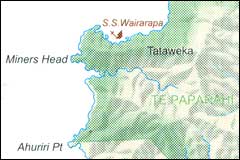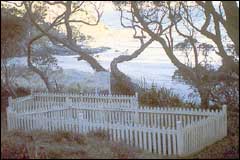|
|
|||
|
||||
|
Updated: September 12, 2001 |
|
|
|||||||||||||||||||||||||||||||||||||||||||||||||||||||||||||||||||||||||||||||
 In 1894, the SS Wairarapa was heading for Auckland when it lost its course and ran aground near Miners' Head |
|
 This cemetry for victims of the sinking of SS Wairarapa is north of Whangapoua Beach |
The steep cliffs and jagged rocks around the coast of Great Barrier Island have proved dangerous to shipping in the Hauraki Gulf area. Over 30 wrecks are strewn around its coastline.
The most famous wreck was of the SS Wairarapa. On Midnight 29 October 1894 the ship ran ashore on rocks near Miner's Head. 140 people drowned. Some were buried on the island at cemeteries at Onepoto and Tapuwai. Today these cemeteries are historic reserves.
Another shipping disaster occurred in May 1922 when the Wiltshire steamer was wrecked in Rosalie Bay. This area is now used by recreational divers to explore the ship's remains.